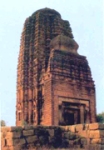Yogini Temples
 Orissa has the distinction of preserving two of the outstanding temples of goddess Yogini, one at Hirapur, a village near Bhubaneswar and another at Ranipur-Jharial in Bolangir district.
Orissa has the distinction of preserving two of the outstanding temples of goddess Yogini, one at Hirapur, a village near Bhubaneswar and another at Ranipur-Jharial in Bolangir district.
An important center of Tantricism and Shakti the temple was built in the 9th century AD.
The Yogini temples were build by the Bhauma and Somavamsis rulers of Orissa. The growth of Yogini cult is traced to the rural and tribal form of worship. The goddess Yogini derived its form from the local village goddess or the gram devi.
The entire development of Yogini worship and the construction of temples are derived from outside the confines of orthodox Brahmanical tradition. In the villages of India, especially in Orissa, each village has a favored deity.
 The Yogini temple at Ranipur-Jharial has a circular wall just 2 meters high and contains 64 niches within its inner perimeter. All the niches except one contain an image of the Goddess Yogini. Some of the idols are depicted with sensual bodies and ornamented bodices. The temple was worshipped between 9th to 13th centuries AD.
The Yogini temple at Ranipur-Jharial has a circular wall just 2 meters high and contains 64 niches within its inner perimeter. All the niches except one contain an image of the Goddess Yogini. Some of the idols are depicted with sensual bodies and ornamented bodices. The temple was worshipped between 9th to 13th centuries AD.
The Yogini temple at Hirapur was probably built towards the end of the Bhauma rule, i.e., 9th century AD, as the sculptures strongly resemble those of the famous Mukteshwar temple of Bhubaneswar, which was erected in the 9th century. The Hirapur temple is the smallest measuring 30 ft in diameter with stonewalls barely eight feet high. Built of coarse sandstone blocks with laterite in foundation the Yoginis are carved from fine-grained gray chlorite.
The inner walls of the temple have sixty-four niches with sixty Yoginis still in position. Each figure stands upon a large severed human head, holding a curved knife or javelin in one hand and a skull cup in the other. The entrance of the temple has a projecting entrance way flanked by doorkeepers.
The sculptures of Hirapur temple are inordinately graceful as the faces are exquisitely carved depicting a gentle smile and hair style of various styles and heavily ornamented. The architecture of this temple blends an extremely original sculptural tradition with extraordinary workmanship
Some of the Major Architecture in Ancient & Medieval Times in India
Contribute More Facts